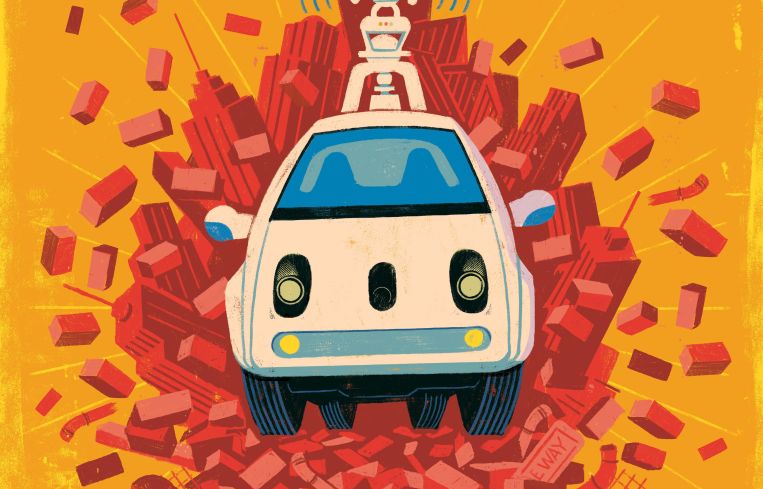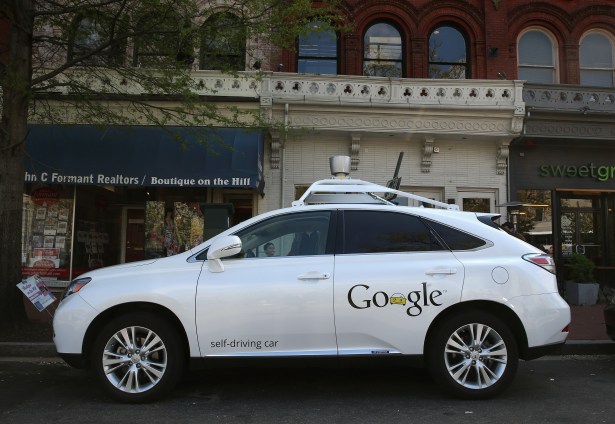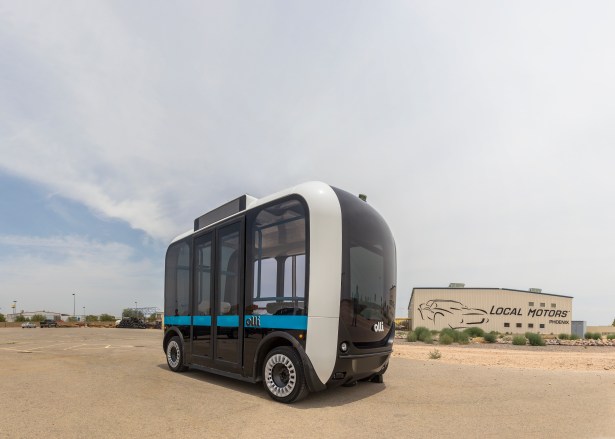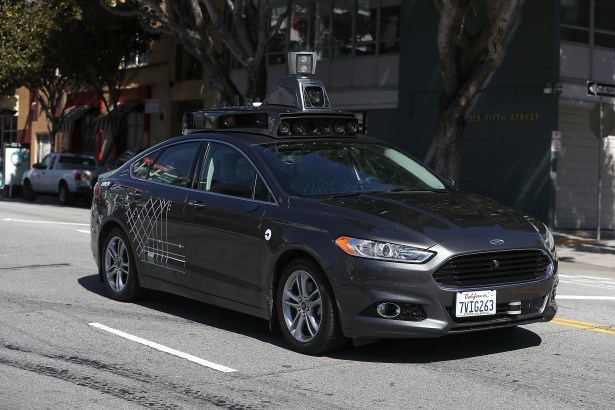No One at the Wheel: What Will Driverless Cars Do to Real Estate?
Uber and Lyft have already started the revolution, but driverless cars promise to upend the way Americans live and work—and real estate with it
By Guelda Voien and Brady Dale October 17, 2017 12:10 pm
reprints
To say that the introduction of driverless vehicles will have both macro and micro effects is a macro understatement.
Automation has and will continue to change the way Americans travel, commute and consume, distribute and own things—everyone from economists to Facebook’s Mark Zuckerberg agrees. And driverless cars are on their way. With Intel’s August acquisition of sensor and navigation software firm Mobileye, another major company formally entered the cutthroat race to develop mass-market driverless cars. Both Ford and GM have already acquired software and artificial intelligence companies; Tesla offers an “autopilot” feature, and Elon Musk contends his Tesla cars ship with adequate hardware to go driverless already. The House of Representatives, in early September, approved legislation that paves the way for driverless cars to, well, get on the road. Comparable legislation has been introduced in the Senate.
What will the inevitable shift toward cars that drive (and park) themselves do to the real estate market? That’s one thing no one agrees on, yet.
“I think the future rarely plays out the way people anticipate that it will,” said Seth Pinsky, an executive vice president at RXR Realty and former president of the New York City Economic Development Corporation. “I think it’s very difficult in the real world to know that what you’re doing will avoid obsolescence many years down the line.”
It’s perhaps a fool’s errand to attempt to anticipate what something as profound as self-driving cars might do to any industry, but Commercial Observer learned that many of the largest real estate companies feel that—at this point—they have no recourse but to try.
The general sense is the industry got caught flat-footed with the housing crisis. It doesn’t want to repeat that with self-driving cars.
Tech experts and real estate pros say the possible effects range from different underwriting to societal upheaval. One industry leader believes that a significant percentage of the American workforce could be rendered moot—and how many office buildings will we need when no one has a job? To say nothing of what that does to the housing market.
At the other end of the spectrum are more immediate, practical changes. For instance, it seems likely real estate developers will build less parking in the future, as the personal vehicle fades from view (not that this is as big an issue in New York City as it is in the rest of the country, but it’s certainly something to consider).
Real estate executives find themselves pondering the smaller, pragmatic choices they face as they brace for the pending larger, more fundamental challenges to their business. Changes in demand and valuation for certain kinds of real estate are already being felt, partly in anticipation of driverless cars’ ubiquity and partly because ridesharing is already a preview of the changes we’re likely to feel.
“For every disruption there is opportunity,” said Spencer Levy, the head of research for the Americas at CBRE. “[But] there are going to be unexpected impacts on certain areas of commercial real estate [no matter what].”
Nico Larco, an architecture professor and co-founder of the Sustainable Cities Initiative at the University of Oregon, was less circumspect. “Land valuation should, in theory, go completely crazy,” he said.
If the cost of transport plummets, it won’t matter nearly so much what’s nearby (unless it’s so nearby it’s walkable).
“The things that will retain value will be based on things that are next to it that create buzz,” Larco argued. “It’s not that distance won’t matter, but it will matter less.”
As a result, real estate is atwitter about driverless cars, with both doomsaying and unbridled optimism—at least on the surface—on show in equal measure.
“It’s like, this weird time where it’s obvious this is going to be a transformative moment in real estate,” said Brandon Huffman of real estate investment manager Rubenstein Partners. “There are all types of theoretical social impacts, including job loss across the board.”
The real estate industry might not need to panic yet, because technologists are taking a longer view. Robert Seidl, a managing partner at Motus Ventures, a fund that focuses on transportation and related industries, is surprisingly sanguine about the issue.
“I think we’re a good 10 or 15 years out on a scale where typical pedestrians would see it,” Seidl said. “Just like electric vehicles take up a tiny, tiny part of the electric space, though they have been poised to take off for a long time.”
John Krafcik, the chief executive officer of Waymo, Google’s robocar company, said much the same thing at Bloomberg’s recent “Sooner Than You Think” conference at the Cornell-Technion campus.
“It’s going to be a transformative technology,” Krafcik said, “but it’s going to unfold over quite a long period of time.”

The Death of the Parking Lot
While Huffman believes we’re 10 years away from a full shift away from personal automobiles, he said the way owners value office buildings is already changing.
“For urban office [product], one-third of the value is in the parking,” Huffman said.
As parking becomes less important, the underwriting to buy and finance such buildings will have to change. Already, those revenue streams have been impacted by Uber, Lyft, Via and the like, he added. “That cash flow is dropping off a cliff,” he said. “We are very wary of investing in a property where value is predicated on parking.”
Levy said developers are more often “opting for horizontal parking decks instead of ramped decks,” because they will be easier to convert to another use when parking is no longer needed.
Georgia Tech City and Regional Planning Professor Subhro Guhathakurta recently supervised research modeling self-driving cars’ impact in the Greater Atlanta area. “We found almost 90 percent of parking would not be necessary,” he told Commercial Observer.
Michael Comras, a Miami-based developer and the owner of an eponymous retail brokerage, said civic leaders are ahead of the curve on the parking issue, like the Miami Beach Planning Board director who told Comras he wishes the city would no longer require parking for new developments.
“Over time, I think this will become more prevalent,” Comras said. In San Francisco, the city has relaxed parking requirements for new buildings, where “a half dozen” residential projects have been built without parking included in recent years, according to the San Francisco Examiner.
Still, what will happen to the existing oceans of parking surrounding suburban apartment buildings, malls and big-box stores? Build on it or raze everything? It could go either way.
Those spaces are already seeing less use thanks to ridesharing.
Ridesharing with drivers will probably never be profitable, so Seidl predicts strange days ahead as the ridesharing startups run out of venture capital money before the software can drive cars.
“We might actually see—before we go forward—a few steps back,” Seidl said.
If Lyft and Uber can’t make money with drivers, they could run out of investor cash before the technology that will save their businesses is ready. If that happens, lawmakers might lose the will to write rules for this new industry. That’s where we might see steps backward.
On the other hand, were the ridesharing companies to wither on the vine, the carmakers might be ready to take their place. That means Detroit still has a shot at dominating the future of the automobile.
Of course, driverless cars will still have to be stored somewhere even if there should likely be many fewer cars in aggregate. Huffman imagines that most people won’t own their own cars. Krafcik described a future where each car costs more and a rider has to pay some kind of subscription to the cloud intelligence that drives it.
On multiple levels, every mile in a self-driving car will cost more, but transportation will probably still make up less of the average American’s budget because people will pay per ride. Levy said many businesses and offices will develop a drop-off and pick-up format, like airports have currently.
There is a consolation prize for the consumer to counter the unpleasantness of continually being dropped off at the airport: the concomitant death of traffic. As smarter cars, which communicate with one another, rule the road, hesitation and error will be nearly eliminated. A surprising side effect of this, in Huffman’s view, will be how viable suburban living could become.
“The biggest problem with living in the suburbs, which is dealing with the commute, is eliminated,” Huffman said, because not only will traffic be largely mitigated but also the car becomes another space where many people can get work done (if you don’t get motion sickness, of course). As the millennial generation—already about a quarter of all Americans—forms households and has children, their renewed interest in the suburbs, which is already evident, is likely to grow, he added. Indeed, almost 50 percent of millennial U.S. homeowners lived in a suburban market in 2016, according to Zillow’s Group Report on Consumer Housing Trends. Meanwhile, 33 percent lived in urban markets—figures contrary to the received wisdom that millennials largely reside in cities (the rest live in rural communities).
But foretelling the death of traffic could be premature. Robin Chase, the founder of Zipcar and an investor in self-driving car companies, said last year that traffic could be just as bad or worse with all the deliveries self-driving cars will make. Policymakers need to think now about rationing those trips.
Policymakers also need to think twice about closing down mass transit options. Even in the robot car future, the dedicated lanes of a rail system could remain the fastest route for many commuters.
Public transport dollars are very long-term dollars, Seidl cautioned. “If they shut down, they are not coming back,” he said.
But there are significant hurdles to a suburban renaissance, as author Richard Florida pointed out in his book The New Urban Crisis. “With their enormous physical footprints, shoddy construction, and hastily put-up infrastructure, many of our suburbs are visibly crumbling,” Florida wrote. The cost of reinvigorating them will not be minor.
Seniors are also likely to be more mobile and self-sufficient with driverless cars providing goods seamlessly and easily escorting the elderly to their doctor appointments and bridge games. The result? Senior housing might not be as important, Levy said.
The sectors that attract the most capital now could be uprooted by this technological change, from senior housing (which provided an average 13.64 percent return on investment over the seven full years prior to second-quarter 2017, per CBRE) to urban housing (about $158 billion in trades in the multifamily sector closed in the U.S. last year, according to data from Real Capital Analytics). Suburban housing and office buildings may recoup those sectors’ losses. “Demographically, [senior housing] looks like a great place to go,” Levy said. “But this is the type of disruptive technology that could change demand.”
The return of the suburbs could in turn reinvigorate the suburban office market, which is practically a dirty word in real estate these days.
“The pendulum may swing back” for the maligned asset class, said Daniel Parker, a senior vice president with Hodges Ward Elliott, an investment sales and real estate financing brokerage. “More and more places could be viable office districts.” One day, inking a lease in Midtown South might not be payday for brokers as it has been of late.
Larco agreed that the suburbs could win. “We point toward more and more sprawl,” he said. “The rest of the city should see a drop in value.”
Guhathakurta isn’t so sure. “Our conclusion was that there will be some amount of dispersion, but it’s not going to be so dramatic as other people have been afraid of,” he argued.
This can be explained in part by price. People behave very differently when a cost is fixed versus when a cost is marginal. Because they pay money each time they get in a car, people who rely on ridesharing take fewer trips than people who own cars. Even if the overall cost is lower, consumers will be aware that they are paying something every time they ride.
Suburbanites without cars will also face a new cost of transport: waiting. If the out-of-pocket cost drops with ridesharing, waiting for your car will be a new cost. Denser areas should have shorter waiting times, though.
Both of these factors could constrain the pressure to live farther away.
Or Musk will invent something no one anticipates that makes owning robot cars super cheap, too. Then, all bets are off.

Pilot Cities
These days, the U.S. is usually left in other countries’ dust when it comes to rolling out infrastructure—just ask anyone who has used Wi-Fi in South Korea. It’s likely that driverless cars, though developed at least in part by American companies, will be no exception, sources said.
Israel, Singapore and other Asian countries are much more likely to become a lab for driverless cars’ implementation than the U.S. for regulatory and logistical reasons, they said.
In the U.S., metropolises could also easily become “have and have-not” cities, Levy said.
In Ann Arbor, Mich., for instance, you can already navigate the University of Michigan’s engineering campus via driverless shuttle buses developed by a French company, NAVYA, as The New York Times reported in July. NAVYA recently opened its North American headquarters in Saline, Mich. It’s one of several companies betting that small commuter buses will be the West’s gateway drug to life without steering wheels. A similar company, EasyMile, also just opened offices in Colorado.
America also has its homegrown trolley companies, such as Local Motors in Chandler, Ariz., which makes a trolley called Olli that can only be described as adorable (like a shoe box with all its edges rounded off and little wheels on the bottom). Seidl’s partial to one of his portfolio companies, which retrofits existing shuttles and cars, Auro Robotics.
All of these companies agree that university and corporate campuses, resorts and amusement parks will see the driverless renaissance first. “Where you have a private, large-ish area and private roads,” Seidl said, “you can go to implementation much faster.”
Meanwhile, in Pittsburgh, Uber’s attempt to roll out driverless cars for ridesharing with the mayor’s blessing seems to be falling apart after nine months, as the Times also reported. The startup allegedly began charging for rides despite its initial promise that they would be free while part of the pilot program, causing Mayor Bill Peduto to lose political capital. City officials and citizens are frustrated that Uber has not created any of the jobs it promised or even shared the traffic data generated by its cars.
But the experimentation in trucking has begun. Uber-owned Otto has already made one autonomous delivery in Colorado. The vehicle automation firm Peloton Technology is winning new laws across the country that lets diesel trucks talk to each other so they can drive very close together, reducing air resistance and fuel costs for trucks. And Starsky Robotics is testing a platform in Florida where humans are still needed, sometimes, but they can drive via remote control from a cubicle in an office.
Distribution Revolution
Driverless cars and improved drone technology, which economists and futurists are even more sure is on its way, will only further cement Amazon’s role as America’s distributor of choice.
“The highest cost in the supply chain for shipping is labor,” Levy said. Eliminating that cost is an obvious call, and driverless cars are going to help. Amazon, needless to say, is likely to be at the forefront of this effort.
Seidl echoed this sentiment. “For Amazon, the end of the supply chain is the house,” he said.
But there’s good news for brokers. While everyone we spoke to generally agreed that warehousing will largely get bigger and more spread out, Larco added that there will also be a need for lots of small warehouses in the most dense urban areas. In fact, we already see Amazon doing just that in New York City with a 50,000-square-foot facility in Midtown and the forthcoming massive fulfillment center on Staten Island. Maybe that’s what we can do with the parking garages?
Various accommodations to facilitate drop-off in urban areas will be needed. Think of how, when Fresh Direct launched its business, New Yorkers complained bitterly about the trucks pausing in the street for deliveries. A whole infrastructure to handle driverless cars’ arrival will be necessary.
Apartment buildings will likely be redesigned to accommodate new modes of distribution, Parker said. Already, the industrial sector is bracing for the changes. “In talking to investors, they are thinking about ways industrial properties can accommodate Amazon’s model where [goods are] delivered in a few hours,” he said. He imagines shopping taking the form of scanning the items you want, leaving the store and finding the items at your door, delivered via driverless car or drone, a few hours later.
And there is likely to be further consolidation among distributors, Parker said, with the gargantuan and expensive task of erecting an infrastructure being possible only for, well, Amazon.
“I saw a tweet recently,” Parker said. “It said, ‘If Amazon wants to be in your business, sell now. If Amazon doesn’t want to be in your business, sell now because your business sucks.’ ”

Diseases of Despair
While there’s always the chance that building that whole new infrastructure can help the job market, this budding technology augurs massive shifts in employment, at best, and a huge uptick in unemployment, at worst.
“We cannot think about autonomous vehicles as a transportation issue. We need to think about autonomous vehicles as an everything issue,” Larco said.
Automation has already been eating into the market for lawyers (with computers doing the lion’s share of tasks that consumed hundreds of hours like document review), and law school admissions have plummeted in response. For the first time in decades, an accredited American law school, California’s Whittier Law School, shut down.
What happens to the massive chunk of the American workforce that drives for a living, when driverless cars dominate the highways? A speaker at the CREFC conference earlier this year pegged the number of Americans who drive for at least part of their job as 30 percent of the workforce; the Los Angeles Times recently said 5 million Americans will lose their jobs when driverless cars are fully implemented. Either number would be devastating to the economy and to real estate.
“The most complicated and controversial of questions [centers on] drivers and jobs and the housing market,” Levy said. With a healthy portion of America automated out of professional relevance, prospects for housing—where the majority of Americans have a financial stake of some kind, either through their own equity or a retirement fund that is tied in some way to real estate—darken. With the lessons of the Great Recession still fresh, real estate executives are scrambling to think of ways to ease this potential shock.
The proposition floating in real estate circles may surprise you: universal basic income.
“The solution that has been suggested is basic income,” Levy said. “But it is the wrong answer.”
Universal basic income (UBI), which has been implemented in pilot programs in Canada and the Netherlands recently, is often explained as “paying people for being alive.” Citizens are given a monthly, unconditional stipend that is sufficient to meet their needs, making income from employment all icing on the financial cake (although it would likely be taxed more heavily). The idea has been around in various forms for centuries but has gained more traction recently. Switzerland held a referendum to offer all citizens a 2,000-francs-per-month UBI last year, but 77 percent of voters said no.
Arguments for UBI range from the philosophical—Thomas Paine thought true individual freedom meant freedom from your employer—to the practical: When disruptions to the economy create shocks like 2008, money, talent and resources go to waste. Putting an easily administered universal safety net in place could cushion people from shocks. Think of providing liquidity to an individual’s personal financial system to incentivize longer-term planning.
A study in Ireland in 2012 showed UBI could be funded there by implementing a 45 percent flat tax with no exemptions—they wouldn’t be needed, after all—on all personal income. In their simulation, they improved financial prospects for more than half of the country’s citizens.
Of course, the idea is usually suggested by thinkers on the political left. But even economists and political scientists on the right, like Charles Murray and Milton Friedman, have argued for versions of UBI, partly because it would streamline the welfare-administrative state.
In America, UBI sounds impossible, but it might be the best mechanism to administer benefits to the growing segments of Americans who are no longer looking for work. In September 2015, the total proportion of Americans participating in the workforce hit 62.4 percent—the lowest percentage since 1977—according to FiveThirtyEight. While employment proportional to the total population has been ticking up slowly since early 2016, the larger trend remains profound, given that unemployment is predicted to grow quickly as automation improves.
Levy thinks UBI won’t help. He cites statistics on the growing number of “deaths of despair” in the U.S., usually defined as those from opioid abuse, alcoholism or suicide. Such deaths have risen steadily since the turn of the last century, according to numerous academic studies.
Clusters of deaths of despair are apparent in areas where industries have died and people, especially men, who want to be gainfully employed sit home, possibly collecting a social benefit. White Americans without a college degree between the ages of 45 and 54—a dominant rust belt demographic—have seen a half percentage increase in mortality rates every year from 1999 to 2013, according to Princeton University economists Anne Case and Angus Deaton.
Levy said that vast swaths of the unemployed, subsisting on UBI, will be even more prone to such deaths. And education is not a fix for this demographic quagmire, he said, because it “takes too long.”
But there aren’t any other apparent answers.


